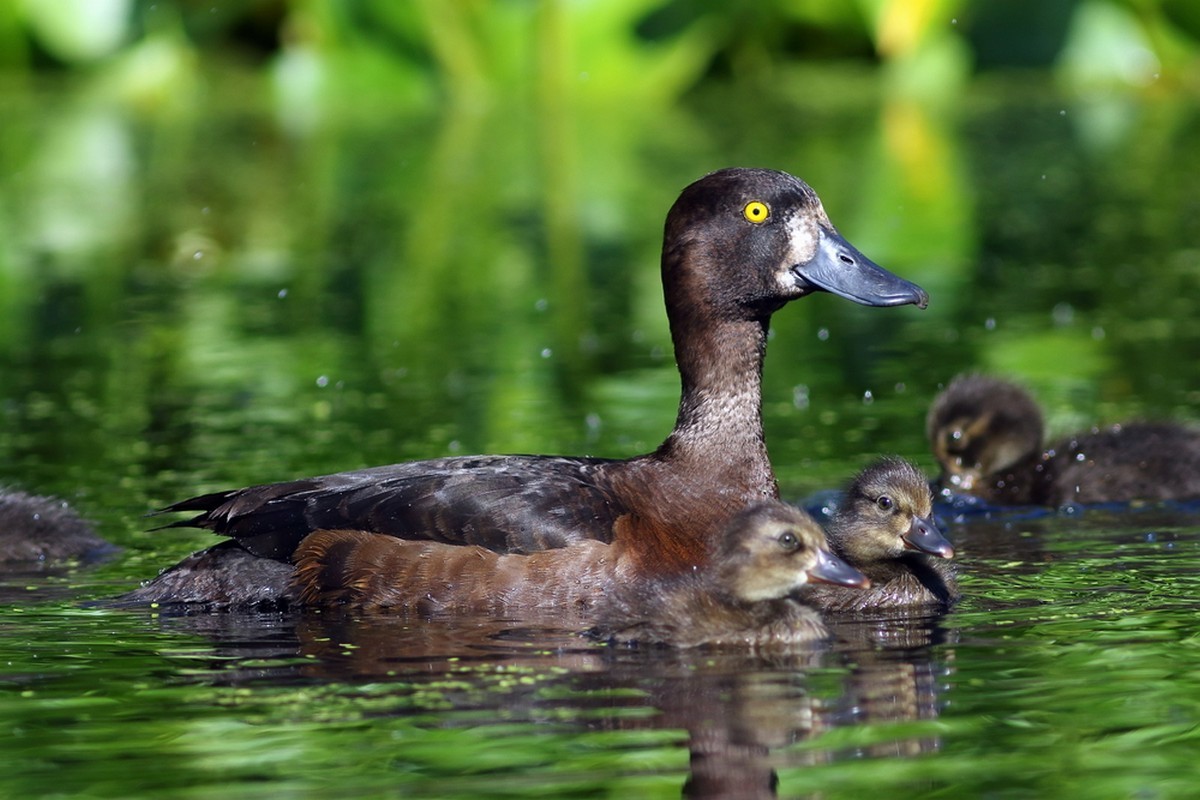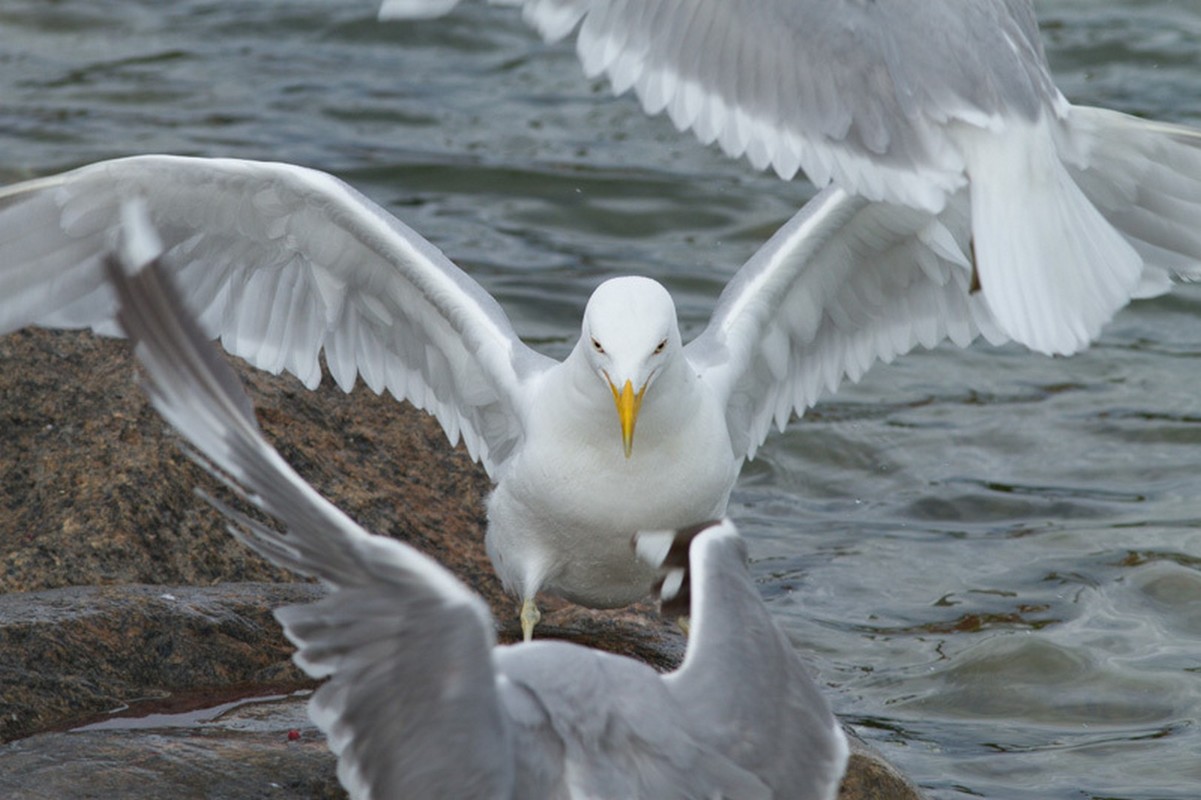10. Birds
Contents
10.1 Birds can fly
If you would try to fly like a bird, you would surely fail. You would quickly realize that unlike humans, birds have a structure that has developed to facilitate the ability to fly. But what are these structural features that make birds such competent fliers?
For birds, the most important feature in terms of their flight ability are their wings, which are covered with flexible feathers.
Bird bones are hollow and light. Birds also have large lungs. Like mammals, birds have four-chambered hearts. The right ventricle of the heart pumps low-oxygen blood to the lungs, while the left ventricle pumps high-oxygen blood to the rest of the body. Because of their effective circulatory systems, birds are able to fly long distances.

The Arctic tern is a skilled flier.
The ability to fy requires precise and effective muscle control. Because of this, bird brains have developed a separate cerebellum that controls the muscle movements needed to fly.
Nesting waterfowl do not need to fly a lot. For them, the more important priorities are to stay hidden from predators and to find food. As a result, waterfowl are often quite clumsy fliers. For example, swans take off quite slowly because of their large size. Likewise, diving duck species, such as pochards, have to run for some distance on the surface of the water before they have amassed enough speed to take of into flight.
Despite the clumsiness of their take-off, most waterfowl are durable fliers once they are in the air. For example, many species of geese migrate between Siberia in the summer and Western Europe in the winter, which is quite a long distance to fly twice every year.
Water environments are also the home for many skilled fliers, such as terns and seagulls. They acquire their food by swooping down to the surface of the water and catching fish in mid-flight.

Canadian goose.
In summary, birds are adapted to flying by having
- large, efficient lungs
- large, developed hearts
- wings
- feathers
- specialized cerebella
- light bones.
10.2 Lake and shore birds
10.3 Birds are homeothermic
Like mammals, birds are homeothermic or warm-blooded animals. This means that their body temperature remains stable despite how cold or warm their environment is. To retain a high body temperature even in cold conditions, birds have thick and compact feather layer, an insulating down layer, a thick layer of fat, and an effective circulatory system. In addition to all of these, birds need to maintain their body temperature from energy they receive from their food.
Waterfowl, such as mallards, geese and swans, have a thick feather layer or plumage. The plumage is so thick and compact that water cannot penetrate it. To maintain the structural rigidity and compactness of their plumage, these birds have preen glands above their tails. The preen gland exudes fat that the bird uses to cover its feathers with. Waterfowl use up a lot of time in the activity of maintaining the condition of their plumage in this way. For them, keeping their plumage well maintained is a matter of life or death.
The feather layer protects a layer of soft, warm feathers called a down layer. The down layer acts as a heat insulant and is kept dry with the help of the protection from the plumage layer. Thanks to these two feather layers, waterfowl can swim in cold water while keeping up their high body temperature.

The common goldeneye maintaining its plumage.
10.4 The mating habits of birds
Many birds have complex mating and courting rituals. For example, the males of many duck species develop a handsome plumage during the spring. Dressed in this courtship plumage, the males begin competing for females by taking part in interesting-looking mating displays. The mating displays consist of ducks showing off the colours of their courtship plumage and by doing species-specific courtship movements. These help the females to distinguish the males of their own species.
Finally, the female duck chooses the male duck it finds the most attractive as its mating partner.
Unlike male ducks, female ducks do not show off. Their plumage is subdued and brown, because this colour provides them with an effective camouflage when they are taking care of their new eggs.

The male northern shoveler has an impressive courtship plumage.
10.5 Bird reproduction
Birds reproduce via internal fertilization. This means that the egg cells are fertilized inside the female.
Munasolun After the egg cell has been fertilized, the egg yolk begins forming. The yolk is the energy supply for the developing baby bird. After the yolk has developed, it gets surrounded by egg white (consisting mostly of proteins) and a hard, protective shell (constisting of calcium carbonite). Finally, the egg is ready to be laid.
The mother bird lays the eggs in a safe location and begins brooding them. During brooding, the mother lies on top of the eggs, keeping their internal temperature high. The brooding time usually takes a couple of weeks. The young birds develop inside their eggs, using the energy and substances of the egg yolk to grow.
When the young waterfowl hatch from their eggs, they are quickly ready the leave the nest. This is important, because the young birds would prove easy prey to predators if they were to stay in the nest for a long time. In water, the young birds are often safer than on land.
 The offspring of many duck species, such as those of the tufted duck (pictured), are often ready to leave the nest soon after hatching.
The offspring of many duck species, such as those of the tufted duck (pictured), are often ready to leave the nest soon after hatching.
10.6 Bird development
10.7 Waterfowl terminology
- Imprinting. When a bird hatches, it does not know what its mother looks like. As a result, it usually gets attached to the character it first sees and recognizes as moving. Most often, such a character is its own mother, but sometimes it can even be a human.
- Nest evasion. Young waterfowl leave their nest soon after hatching. This is why they are called nest-evasive birds. In contrasts, the young of some other bird species, such as those of the great tit, hatch in a less developed state, and stay in their nests for a couple of weeks after hatching.
- Molting. Birds change their feathers regularly. By molting their feathers, their plumage and down stay in good condition. During the molting period, the bird is unable to fly for a couple of weeks, as their wing feathers are yet undeveloped. During this time, the birds often stay hidden in shrubs and other foliage.
 The young goldeneyes have left their nest at a young age and imprinted themselves to their mother.
The young goldeneyes have left their nest at a young age and imprinted themselves to their mother.
10.8 Competition on two levels
Animals compete with each other on two levels.
When someone guts a freshly catched fish on the seashore, the person quickly attracts an entourage of seagulls. Each seagull tries to eat as much of the fish remains as possible. When immersed in this activity, the seagulls will from time to time make noises and aggressive movements at each other. The seagulls are competing for food. As all the birds belong to the same species, the scene is an example of intraspecific competition. Larger individuals usually succeed in getting more food than smaller individuals.

Common gulls competing for fish remains.
The noise made by common gulls attracts other birds. After a while, they are paid a visit by a larger European herring gull (pictured below). Herring gulls are stronger than common gulls, and they will quickly drive the other birds away to eat up most of the remaining food.

An European herring gull (center) driving common gulls away from the fish.
Why don't the herring gulls arrive at the scene straight away to eat the fish? Larger species usually dominate smaller species in nature. However, herring gulls are considerably more shy than common gulls. They will stay away for as long as they see a human near the fish remains. However, immediately when the human leaves the scene, the herring gulls race to drive away the common gulls from the food. This situation is an example of interspecific competitions.
10.9 Each species has its own ecological niche
Mallards are dabblers.
Multiple species can inhabit a certain ecosystem because they each have their own ecological niche. An ecological niche is determined by the species' living habits.
Let's take mallards as an example. Mallards are a duck species that often inhabit lakes and other freshwater ecosystems. They are dabbling waterfowl, which means that they are unable to dive in search for food, instead only tipping their bodies halfway under the water. Because of this, they search for food mostly in shallow shore areas. Mallards eat mostly plants and small animals found in the shallow shore water. Thus, the ecological niche of mallards can be outlined as shallow lakeshores.
Tufted ducks often inhabit the same lakes and areas as mallards. They too eat plants and animals they find under water. Why have the tufted ducks driven away mallards completely from these ecosystems?
The reason is that tufted ducks are diving birds. As a result, they can search for food in deeper waters than mallards can. Thus, the ecological niche of the tufted duck can be outlined as the areas of the lake that are deeper than the shallow shore.
In nature, a constant interspecific competition is very taxing on organisms. This is why we can observe different ecological niches instead of a constant struggle for resources when observing the natural world. Ecological niches provide each species with sufficient resources to live, survive, and reproduce.

Tufted ducks are divers. The picture shows a female diving under water in seach of food.



